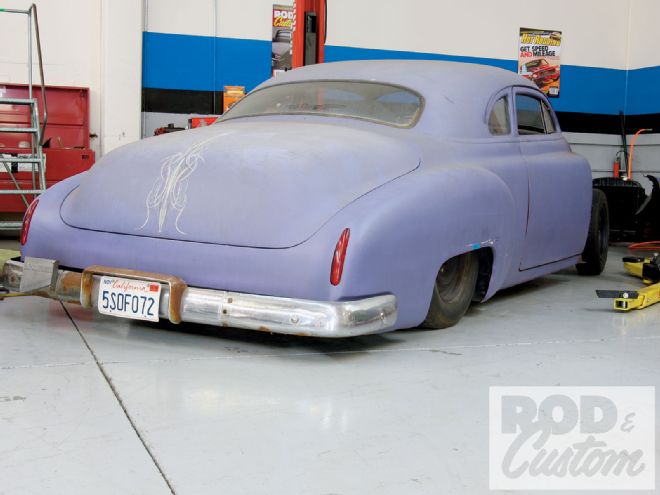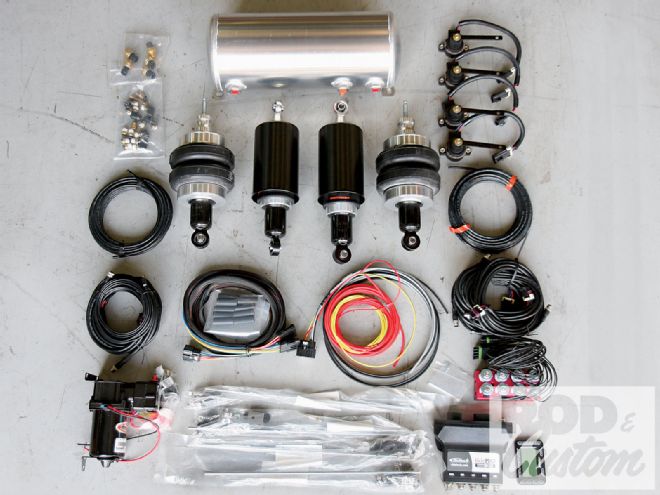
Around a decade ago now, when the Purple Pig first came into my possession, one of the first jobs after replacing the entire lower 8 inches of bodywork and chopping the roof, was to cut the front coil springs and add dropped spindles, and fit crazy 6-inch lowering blocks to the rear. Just before the '49 was loaded on a British ship bound for California, I C-notched the rear of the chassis, still with the leaf springs and blocks. The car has always ridden low-probably too low as it had a mere 1/4-inch of suspension travel until I notched the frame, so when its long-overdue revamp was planned, rear airbags were part of the equation. Indeed, they'd been the intended reason for the C-notch.
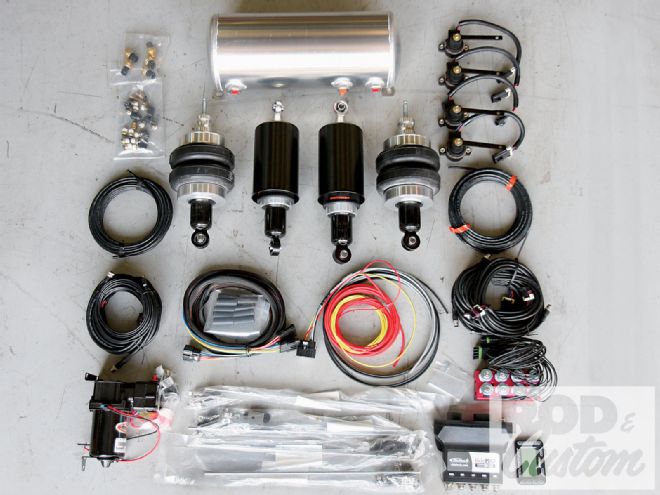 I haven't yet mentioned which management system I'll be using, as we'll cover that next month (it's the latest RidePro e3), but here's the complete package I received from RideTech, extremely comprehensive right down to PTFE tape already installed on all the air fittings.
I haven't yet mentioned which management system I'll be using, as we'll cover that next month (it's the latest RidePro e3), but here's the complete package I received from RideTech, extremely comprehensive right down to PTFE tape already installed on all the air fittings.
However, with the inclusion of the Classic Performance Products trailing arm rear suspension, the notion of 'bags was quickly ousted in favor of ShockWaves (from Air Ride Technologies, now known as RideTech), and followers of the project will remember the rear of the car sitting very low with aluminum ShockWaves when the rearend install was complete. Unfortunately for me, those were merely on loan from CPP! I figured I'd only run ShockWaves in back, as the coil-sprung Chassis Engineering IFS that came next would work just fine, thank you. But it just wasn't low enough for my liking, despite setting the neat adjustable upper spring mounts to their highest (and hence lowest ride height) setting. I'll admit I like my cars lower than most, though still with a safe scrubline, and the Chassis Engineering suspension is ideal for many people. When I heard that RideTech was introducing budget versions of the ShockWave in steel, known as the Black Series, not only did they appeal to my lowly journalistic pocketbook, but I could see a way to get the front of the Chevy as low as the rear.
Which in my usual drawn-out fashion, brings me to this latest installment of the Project '49. Until now all the parts used on the Chevy have been of a bolt-in design, a conscious move on my part to show how a project car can be built with minimal fabrication. OK, there's been a little welding, such as the bearing mount in the steering linkage, but in the main everything was bolted in. Until now. While the CPP rear suspension is designed for the ShockWaves to bolt to brackets on the trailing arms, upper mounts had to be fabricated owing to my C-notch. Up front, however, I had some planning and fabrication to undertake; likewise in the trunk, where the air pump, tank, and solenoid block were to be mounted. While there's no reason to go as fab-crazy as I did back there, as you'll see, this all needs mounting somewhere. So the air suspension installation will be split into two parts, with the heavy fabrication work covered this month, and the plumbing, electrical hookups, electronic suspension management system, and level sensors in the next issue. So with the welder fired up, grinders and air tools at the ready, and the Emergency Room on standby, let's begin.
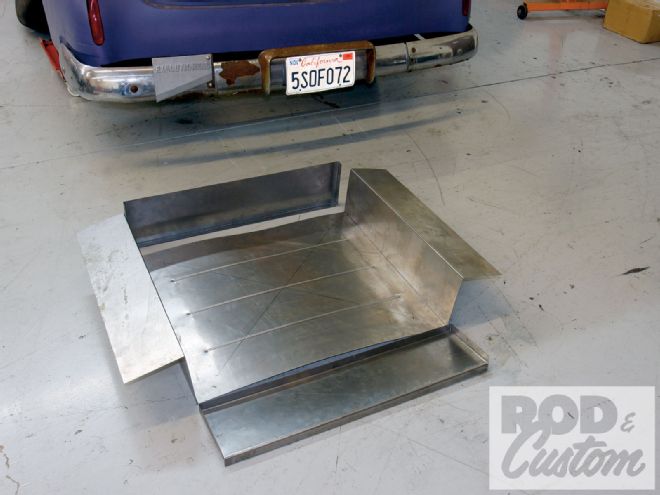 Though the C-notch was already done, and the lower A-arms took some figuring out, one of the most time consuming fabrication jobs was the sunken trunk floor. Obviously not necessary in every case, I have a family that requires trunk space (for the luggage, not the kids!) and wanted to hide the air suspension components and Aeromotive gas tank under the floor, so I made this "box" to take up the space where the stock tank resided, as well as to leave space on either side for the exhausts to run alongside the chassis.
Though the C-notch was already done, and the lower A-arms took some figuring out, one of the most time consuming fabrication jobs was the sunken trunk floor. Obviously not necessary in every case, I have a family that requires trunk space (for the luggage, not the kids!) and wanted to hide the air suspension components and Aeromotive gas tank under the floor, so I made this "box" to take up the space where the stock tank resided, as well as to leave space on either side for the exhausts to run alongside the chassis.
Steel Yourself Introduced in 1999, the original aluminum-bodied ShockWave, now called the Master Series, was a significant development in air suspension, allowing the air spring and shock absorber to become a single component, rather than having to mount shocks off the side of suspension arms and the like. RideTech invented the ShockWave, and holds two U.S. patents for the design and function. Over the past decade, the Master Series has been refined, now offering single or double adjustable shock valving, optional internal ride height sensors, multiple air spring configurations, and a wide range of stroke lengths, load capacities, and mounting styles, the most common being eye or stud mounts.
RideTech has recently added two new versions of the ShockWave: the Titanium Series, which features 24 position compression and rebound valving, remote reservoirs and a monotube gas pressure design, which I guess will appeal to the road racers and track day stars out there who want optimum handling and the ability to fine-tune their ride quality in a high-tech package; and the Black Series, a twin-tube steel body shock that retains all the mounting and installation advantages of the Master Series, but is comparable in price to a separate airbag and shock system. However, the Black Series isn't available with internal ride height sensors.
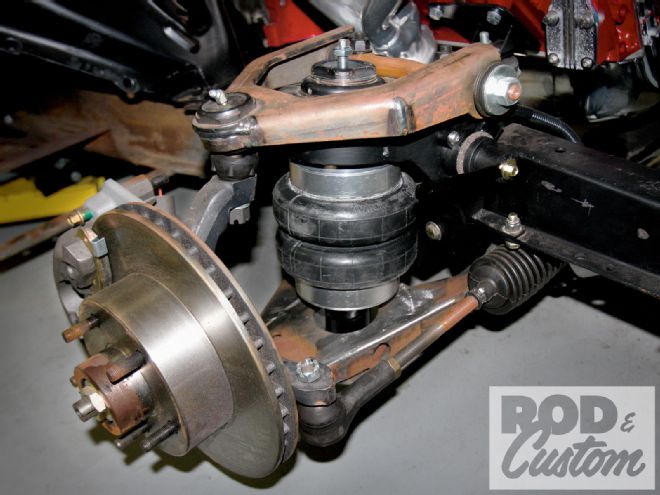
Not My Bag RideTech offers two types of airsprings; double convoluted and rolling sleeve. The former has more load capacity, a shorter stroke and a more progressive spring rate, making it appropriate for front end applications, where the weight of the engine and trans require the increased load capacity. The rolling sleeve design has a longer stroke, more linear spring rate and usually a smaller diameter. The short stroke of the double convoluted design isn't a problem, as most front ends mount the spring inboard of the load point, meaning the stroke length is almost doubled at the actual wheel.
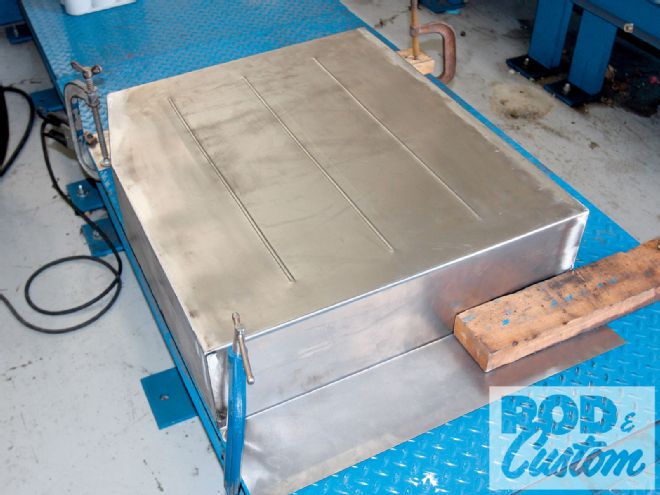 After using up yet another favor and taking over Circle City Hot Rods' bender and bead roller for a couple of hours, I clamped the three sections to the only suitable large flat metal object available at our tech center-the rolling road-and welded it into a single component.
After using up yet another favor and taking over Circle City Hot Rods' bender and bead roller for a couple of hours, I clamped the three sections to the only suitable large flat metal object available at our tech center-the rolling road-and welded it into a single component.
While RideTech can supply bespoke kits for a number of vehicles-mainly muscle cars, pickups, and Tri-Five Chevys-they can supply components for a custom install, which is what I was looking at with the project Chevy. A number of aftermarket Mustang II-based IFS systems are also covered, though Chassis Engineering's crossmember isn't one of them, so I had to do a little math, a lot of thinking, and some fabrication to make it all work correctly, ensuring the recommended ride height of the ShockWave was adhered to, and that the suspension geometry was where it should be at ride height too. Add in the fact that the airspring must not touch any part of the chassis or body throughout its travel, no components should hang below the scrubline at ride height, or touch the ground on full drop, plus I wanted the finished deal to look neat, and there was a lot to consider.
Off the rack and sitting on its wheels with the ShockWaves fully deflated, it's obvious the car sits slightly nose-high, though the dropped spindles will rectify this. Apart from a psychological boost, there's a reason for this step. I wanted to ensure nothing could touch the ground at full drop, and also check that none of the suspension parts hit the body either. In the event of catastrophic failure I want to be able to steer the car to the side of the road, not be sliding along the blacktop with sparks flying. The rearend differential yoke does hit the driveshaft tunnel, so that will need rectifying despite me having raised the tunnel once already. However, this was a closed driveline car previously, and I wasn't too concerned if the torque tube kissed the tunnel every once in a while. In all seriousness, low cars look cool, but safety has to be considered foremost. Ask me sometime of my personal experiences of a modified car I bought whose builder ignored scrublines and why I like to fit front driveshaft loops!
